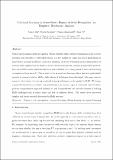Files in this item
Continual learning in sensor-based human activity recognition : an empirical benchmark analysis
Item metadata
| dc.contributor.author | Jha, Saurav | |
| dc.contributor.author | Schiemer, Martin | |
| dc.contributor.author | Zambonelli, Franco | |
| dc.contributor.author | Ye, Juan | |
| dc.date.accessioned | 2022-04-15T23:41:24Z | |
| dc.date.available | 2022-04-15T23:41:24Z | |
| dc.date.issued | 2021-04-16 | |
| dc.identifier | 273768558 | |
| dc.identifier | 7bad7995-ef2d-46cc-bed1-c72bb5d76210 | |
| dc.identifier | 85108597212 | |
| dc.identifier | 000698504400001 | |
| dc.identifier.citation | Jha , S , Schiemer , M , Zambonelli , F & Ye , J 2021 , ' Continual learning in sensor-based human activity recognition : an empirical benchmark analysis ' , Information Sciences , vol. In Press , pp. 1-35 . https://doi.org/10.1016/j.ins.2021.04.062 | en |
| dc.identifier.issn | 0020-0255 | |
| dc.identifier.other | ORCID: /0000-0002-2838-6836/work/92775851 | |
| dc.identifier.uri | https://hdl.handle.net/10023/25197 | |
| dc.description.abstract | Sensor-based human activity recognition (HAR), i.e., the ability to discover human daily activity patterns from wearable or embedded sensors, is a key enabler for many real-world applications in smart homes, personal healthcare, and urban planning. However, with an increasing number of applications being deployed, an important question arises: how can a HAR system autonomously learn new activities over a long period of time without being re-engineered from scratch? This problem is known as continual learning and has been particularly popular in the domain of computer vision, where several techniques to attack it have been developed. This paper aims to assess to what extent such continual learning techniques can be applied to the HAR domain. To this end, we propose a general framework to evaluate the performance of such techniques on various types of commonly used HAR datasets. Then, we present a comprehensive empirical analysis of their computational cost and of their effectiveness of tackling HAR specific challenges (i.e., sensor noise and labels’ scarcity). The presented results uncover useful insights on their applicability and suggest future research directions for HAR systems. | |
| dc.format.extent | 35 | |
| dc.format.extent | 2286197 | |
| dc.language.iso | eng | |
| dc.relation.ispartof | Information Sciences | en |
| dc.subject | Human activity recognition | en |
| dc.subject | Continual learning | en |
| dc.subject | Lifelong learning | en |
| dc.subject | Incremental learning | en |
| dc.subject | QA75 Electronic computers. Computer science | en |
| dc.subject | T Technology | en |
| dc.subject | T-NDAS | en |
| dc.subject | SDG 3 - Good Health and Well-being | en |
| dc.subject.lcc | QA75 | en |
| dc.subject.lcc | T | en |
| dc.title | Continual learning in sensor-based human activity recognition : an empirical benchmark analysis | en |
| dc.type | Journal article | en |
| dc.contributor.institution | University of St Andrews. School of Computer Science | en |
| dc.identifier.doi | 10.1016/j.ins.2021.04.062 | |
| dc.description.status | Peer reviewed | en |
| dc.date.embargoedUntil | 2022-04-16 |
This item appears in the following Collection(s)
Items in the St Andrews Research Repository are protected by copyright, with all rights reserved, unless otherwise indicated.

